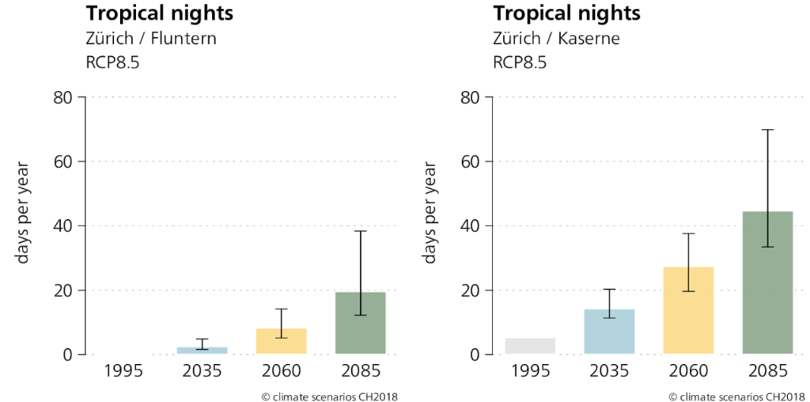C2SM Newsletter vol. 35

Topics in this Newsletter – September 2022
- Modelling Activities and Services
- News from EXCLAIM
- News from Joint Activities on Climate Scenarios
- News from the C2SM Community
- Upcoming Events
- Selected Press Articles
- Paper: The role of atmospheric dynamics and large-scale topography in driving heatwaves
- Paper: COSMO simulations of ice clouds in the West African monsoon
- Paper: Lagrangian Particle Dispersion Models in the Grey Zone of Turbulence: Adaptations to FLEXPART-COSMO for Simulations at 1 km Grid Resolution
- Paper: An ensemble-based statistical methodology to detect differences in weather and climate model executables
- Paper: 21st Century Alpine Climate Change
- Paper: Internal variability and decadal-scale trends of surface solar radiation
- Paper: Aerosol’s fingerprint on clouds: Increases in cloud cover appear to dominate the cooling effect
Sustainable Pathways of Environmental and Energy Development towards Net Zero Switzerland) was approved by ETH Board. The proposal had been part of the external pageETH Board call on Strategic Area Energy, Climate and Environmental Sustainabilitycall_made published in January 2022.
SPEED2ZERO is a three-year and 20 million Swiss Francs project headed by Prof. Reto Knutti, chairman of C2SM. It will start in 2023 and involves 43 partners from ETH Zurich, EPFL, Empa, EAWAG, WSL, and PSI. It also involves the ETH centers C2SM, the Energy Science Center ESC, Materials and processes MaP, and the Center for Sustainable Future Mobility CSFM. It is planned to hire more than 30 postdocs and a project office team. The aim of the project is to develop toolboxes, action plans, and technology to enable sustainable transformation to net zero greenhouse gas (GHG) and biodiversity-positive Switzerland. The solutions developed will target immediate action conducive to halving GHG emissions by 2030, developing the required infrastructure, ensuring a resilient energy system, and securing biodiversity.
Modelling Activities and Services
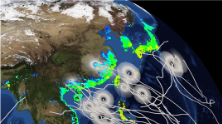
Working Group 1 (WG 1): High Performance Computing
Containerisation is the packaging of software code with just the operating system libraries and dependencies required to run the code to create a single executable—called a container—that runs consistently on any infrastructure. C2SM core team was able to put a GPU-capable version of COSMO 6.0 into a container. The containerised executable is running as fast as an executable directly built on Daint at CSCS, and more importantly, the physical results are not affected by the container. This is a great success as previous attempts could not achieve correct results for COSMO inside a container. The know-how to containerise complex GPU-applications is very valuable since containers could play a major role in the project EXCLAIM and the upcoming system "Alps" at CSCS.
Contribution to the OpenACC port of the 2-moment cloud microphysics scheme in ICON
The 2-moment cloud microphysics scheme by Seifert & Beheng (2006, external pagehttps://doi.org/10.1007/s00703-005-0112-4call_made) improves the representation of clouds and precipitation in weather and climate models. It adds important microphysical processes like the evolution of mass and the number densities of different hydrometeor types like cloud droplets and ice crystals. However, the complexity of the scheme requires long computing times. To speed it up, C2SM, together with MeteoSwiss, added OpenACC directives to the scheme that allow it to run on GPUs (graphics processing units), whereas the original code could only run on CPUs (central processing units). While the main part of the scheme can now be executed on GPUs, C2SM will continue to work on its optimisation in an ongoing project.
Working Group 2 (WG 2): Development of Weather and Climate Models
Integrating a vegetation model into ICON-ART
The Vegetation Photosynthesis and Respiration Model (VPRM) is a parameterisation, which describes the carbon dioxide (CO2) exchange between the atmosphere and the biosphere, and which is already used in many atmospheric chemistry models. As input, VPRM requires maps of vegetation cover, downward shortwave radiation, 2-meter temperature, enhanced vegetation index (EVI), and land surface water index (LSWI), both of which are calculated from MODIS (Moderate Resolution Imaging Spectroradiometer) satellite measurements. Since meteorology drives CO2 uptake and release by vegetation, it is useful to couple VPRM directly to a meteorological model. As part of a planned task requested by Empa, VPRM was integrated into ICON-ART as part of its Online Emission Module (OEM). This implementation will be included in the next ART release. In addition, the conversion of MODIS data to vegetation indices and mapping to the ICON grid was automated in the pre-processing.
Visualisation of ICON model output with icon-vis
ICON is replacing more and more modelling activities in the field of research, but also for operational forecasts. Visualising model output on the native ICON grid is a key point for research and development. However, the unstructured grid of ICON cannot be plotted by most common plotting routines. Therefore, C2SM together with MeteoSwiss has developed a collection of plotting routines using up-to-date Python packages, which is publicly available at external pagehttps://github.com/C2SM/icon-viscall_made.
Working Group 3 (WG 3): Climate Scenarios
To prepare the next generation of climate scenarios in the framework of the Klima CH2025 project, the C2SM EURO-CORDEX database was updated and the additional simulation data were evaluated. The increased database does not change the main picture and the results from the last published climate scenarios, external pageCH2018call_made, remain valid. This result is also supported by the work carried out by Maximilian Gorfer within his internship at Meteo Schweiz (“maternity replacement” of Ruth Lorenz). Maximilian compared CMIP5 and CMIP6 global modelling runs in the framework of global warming levels. While substantial differences between models exist in terms of temporal characteristics, high qualitative and quantitative agreement for the global and regional response at specific warming levels exist. Therefore, research and scenario products based on CMIP5 do not lose validity.
At the moment C2SM core staff is working on making high resolution convection resolving regional climate modelling data available for the C2SM community. This data was produced during the EUCP project by the group of Christoph Schär and partners from all over Europe. This data will complement the scenario data available from CH2018 and the updated database for Klima CH2025.
ICON-CLM tool and input data
Regional climate simulations with the ICON Climate Limited Area Mode (ICON-CLM) model can be driven by meteorological reanalysis data, such as external pageERAInterimcall_made and external pageERA5call_made. These datasets are now available on the Piz Daint supercomputer at CSCS. They range from the year 1979 onwards and will be regularly synchronised with the original dataset at the servers of the Deutsches Klimarechenzentrum (DKRZ). The “Starter Package for ICON-CLM Experiments” (SPICE) was updated to the latest version 2.0, including necessary adaptions to run these experiments on Piz Daint.
Working Group 4 (WG 4): Climate Impacts
One of the main needs of C2SM’s climate impacts community that has crystallised is a need for standardised, documented data sets with easy access. C2SM provides access to a number of datasets and has collected information on the wiki (https://wiki.c2sm.ethz.ch/Datasets). We provide datasets such as external pageCMIP6call_made or external pageCORDEXcall_made as downloaded from the Earth System Grid, but also some datasets that have been processed in a certain way. For instance, C2SM has taken over the CMIP6-NextGeneration (CMIP6-NG) archive from Reto Knutti’s group. CMIP6-NG contains a number of variables which have been checked for physical plausibility, standardised where necessary and also regridded to a common grid. Similar efforts have been done for the re-analysis dataset MERRA-2 as an example. The originally hourly external pageMERRA2call_made data is available for some variables on the same grid as CMIP6-NG as daily and monthly data.
News from Joint Activities on Climate Scenarios
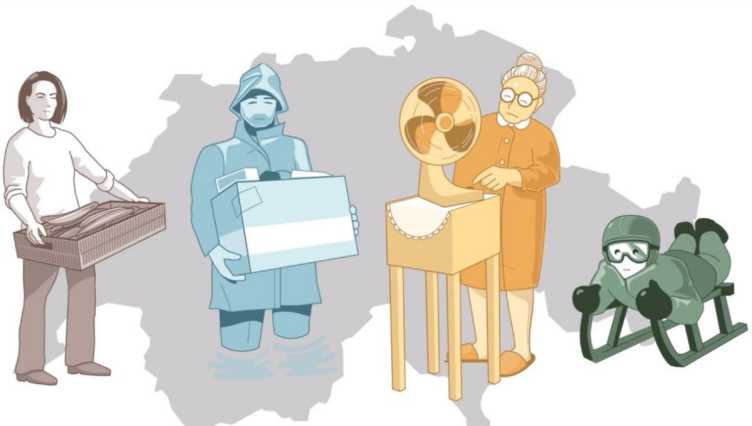
New heat indicators for Swiss cities in CH2018
Temperatures in cities are usually higher than in rural areas - an effect that is referred to as the urban heat island (UHI) effect. It leads to an increased risk of heat stress for the urban population during the summer months. In order to better assess future climatic conditions in cities, the heat indicators of the current Swiss climate scenarios CH2018 have been extended to include selected Swiss city centres. Using the statistical method described in Burgstall et al. (2021; external pagehttps://doi.org/10.1016/j.cliser.2021.100228)call_made, the heat indicators for selected city centres have been calculated on the basis of paired observational data and the CH2018 climate scenarios. For the city centres of Basel, Bern, Geneva, Lausanne, and Zurich, the indicators tropical nights, summer days and hot days are now available via the external pageCH2018 web atlascall_made under "Indicators at stations". For the city stations, select the station at the bottom of the list with the addition "CITY CENTER". Find below an example of the future evolution of the number of tropical nights per year at Zurich Fluntern (rural station) and at Zurich Kaserne (urban station) assuming RCP8.5 greenhouse gas concentrations.
News from the C2SM Community
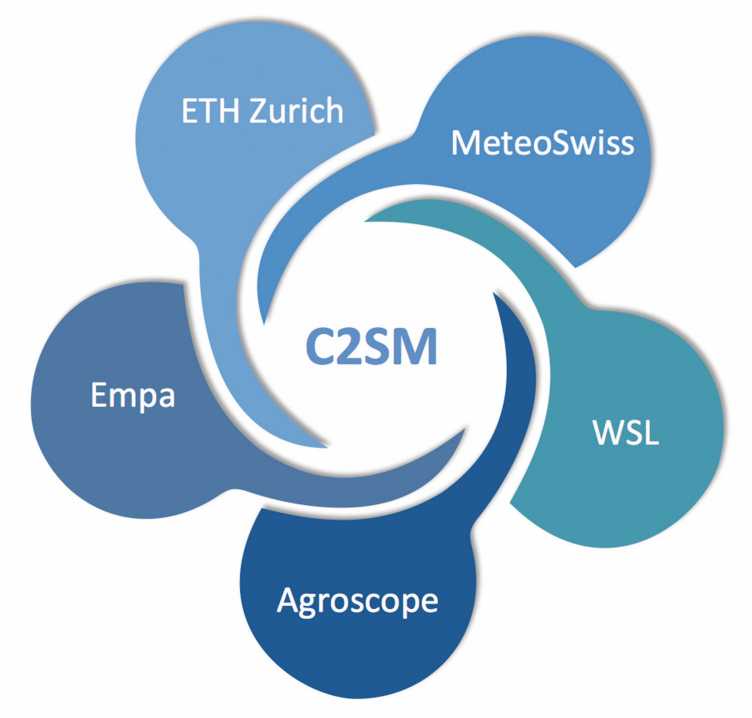
NCCS-Impacts programme: Start of internal project contributions and end of public call for proposals
In the National Centre for Climate Services (NCCS) programme «Decision Support for Dealing with Climate Change in Switzerland: a cross-sectoral approach» («NCCS-Impacts»), actionable climate services for the environment, economy, and society will be developed. Between 2022 and 2025, several cross-sectoral and interlinked projects will be implemented. For four of the projects, a public invitation to tender was open from the beginning of June until the end of August 2022. The submitted bids will be assessed by numerous experts from different fields in the coming months. Meanwhile, some of the NCCS members or partners ETH Zurich, WSL, BLV and Agroscope, who are involved in the projects with specific services in the form of internal contributions, have already started with their work. More information on NCCS-Impacts is available online: external pagewww.nccs.admin.ch/impacts-encall_made
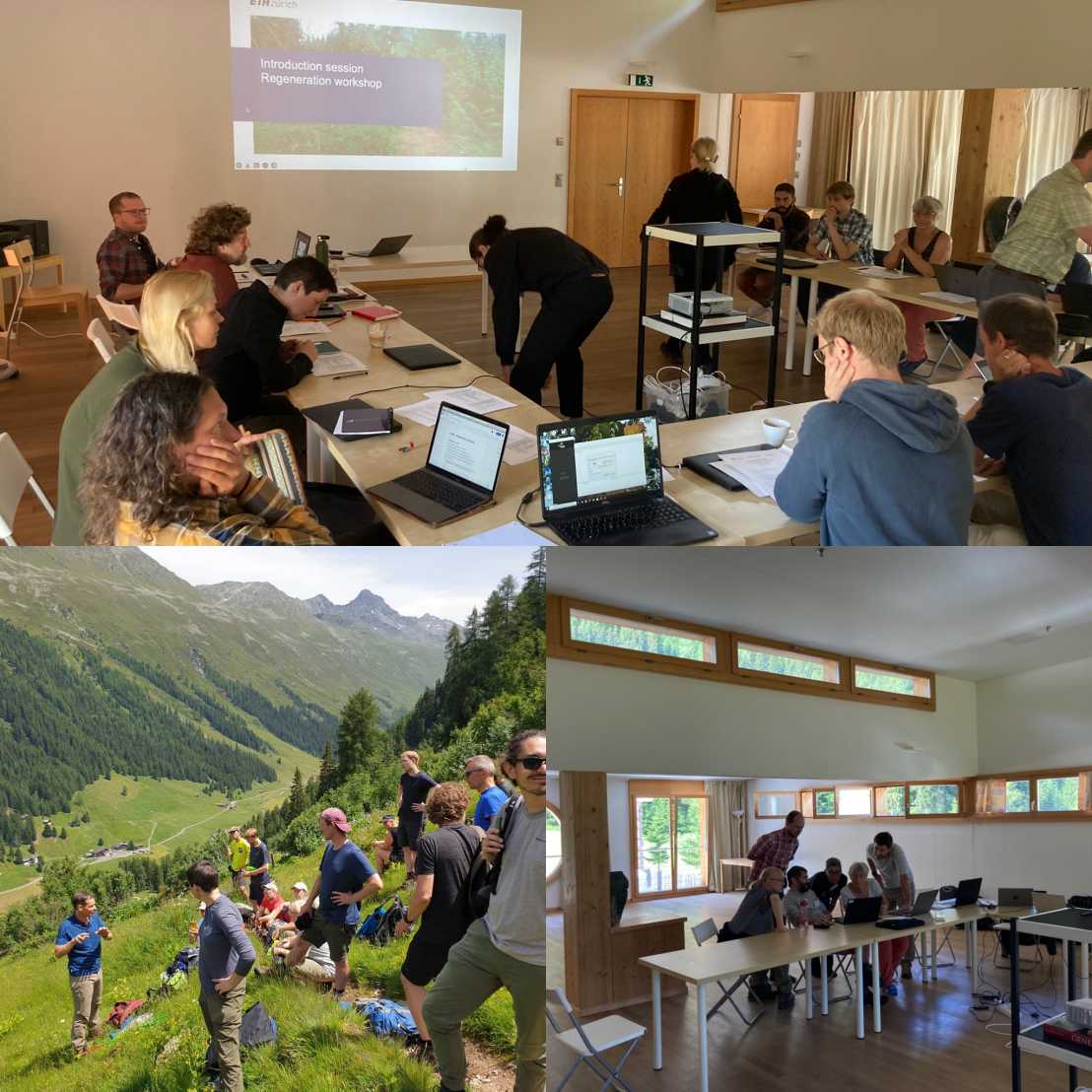
The tree regeneration modelling workshop last June was a success
The international tree regeneration workshop organised last June in Davos gathered 20 researchers from 14 vegetation modelling teams and 12 institutions. Vegetation models are fundamental tools to understand the impact of changing climates on forests. Tree regeneration is an essential ecological process in forest dynamics, but until now many vegetation models had represented this process based on limited data and without benchmarking their outputs against large datasets; therefore, it has been very challenging to assess how well tree regeneration was represented across a wide range of environmental gradients or using alternative model structures.
The main objective of the gathering was to explore the outcomes from the different models and explain why different model structures and complexities provided different results, and to ultimately provide recommendations for future modelling of this important ecological process in forest dynamics. We consider this workshop a success because all the modelling teams were able to provide simulations before the workshop, the participants were extremely engaged, and the discussions and further work developed during the workshop has set a solid base to produce at least one publication that will be of interest for a wide modelling community. This publication will provide recommendations to enhance the robustness of dynamic vegetation models to study global change effects. Stay tuned for interesting results!
The workshop was organised by the Forest Ecology group at ETH and funded by the COST Action PROCLIAS and ETH Zurich. For more information, contact Harald Bugmann (), Yannek Käber () or Olalla Díaz-Yáñez ().
ETH-Klimarunde 2022
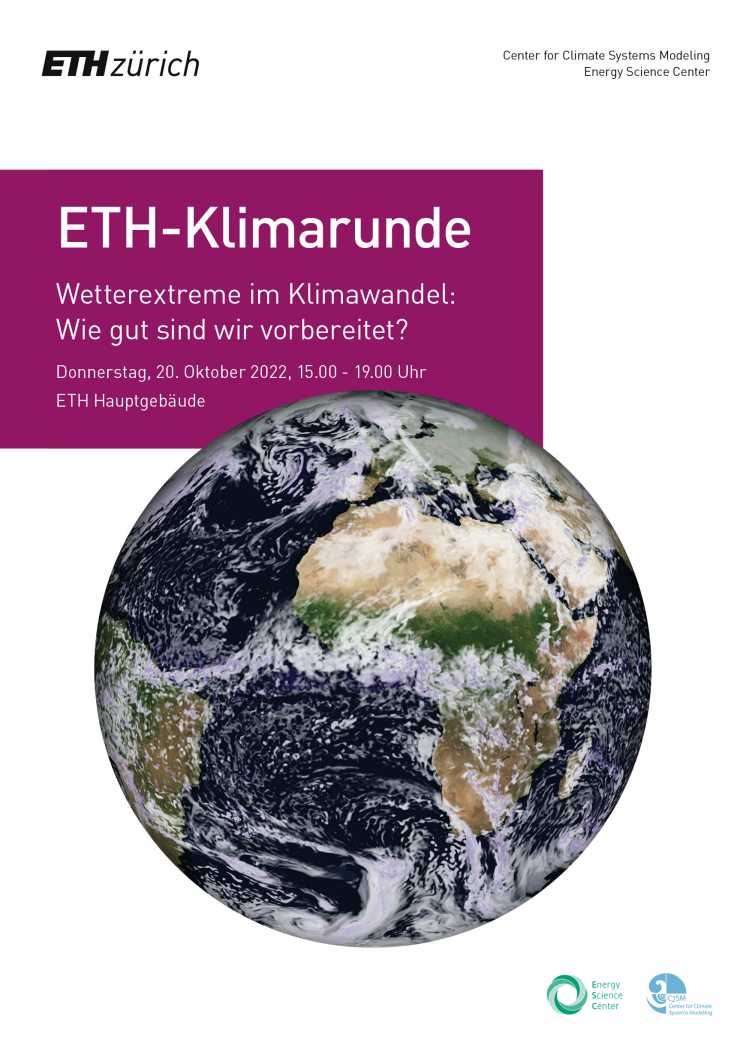
Wetterextreme im Klimawandel: Wie gut sind wir vorbereitet?
Registration offen: Melden Sie sich jetzt für die Klimarunde an!
Donnerstag, 20. Oktober 2022 von 15.00 bis 19.00 Uhr, ETH Hauptgebäude
Online Anmeldung und Programm: https://c2sm.ethz.ch/events/eth-klimarunde-2022.html
NCCS-Forum: Save the date
The fifth NCCS Forum will take place in Biel/Bienne on the morning of Wednesday, 16.11.2022 (in German and French). In the afternoon, the 13th Symposium on Adaptation to Climate Change will conclude the event day. Further information on the programme and registration will follow soon on external pagewww.nccs.chcall_made
Join us for the C2SM Community Day
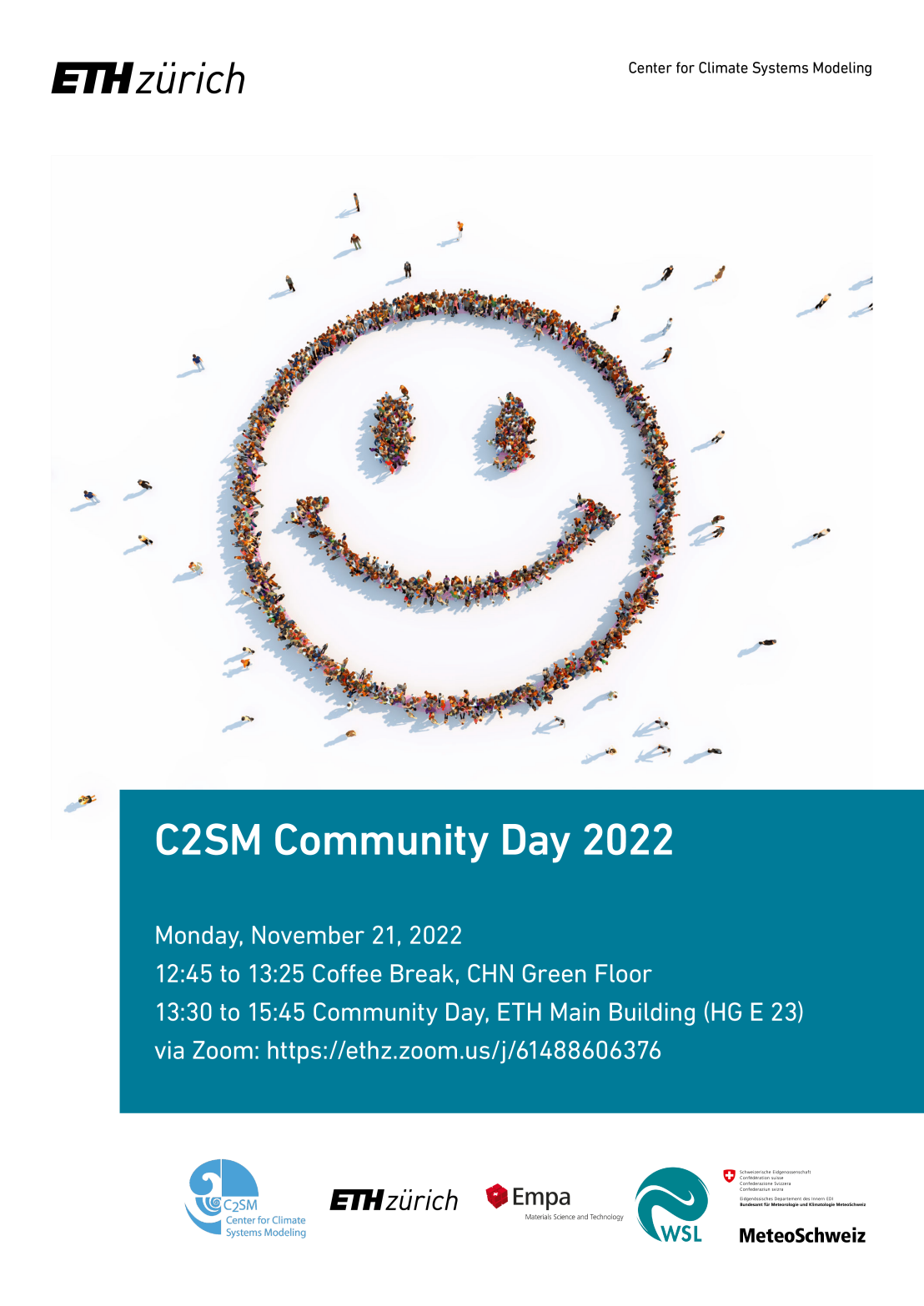
Monday, November 21, 2022
Selected Press Articles

- TA Media Online: «So heiss wird es in Zürich / Basel / Bern in 40 Jahren», Dr. Andreas Fischer, 12.08.2022; external pageTages Anzeigercall_made; external pageBasler Zeitung;call_made external pageBerner Zeitungcall_made
Highlighted Papers from the C2SM Community
The role of atmospheric dynamics and large-scale topography in driving heatwaves
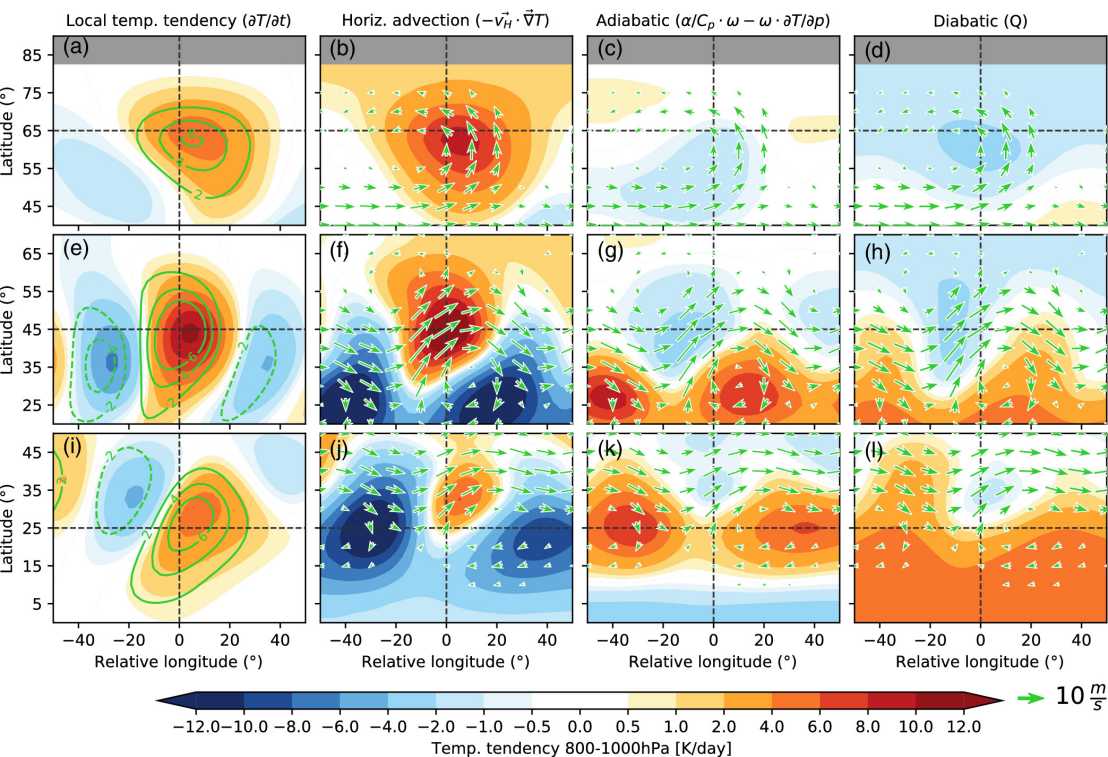
Heatwaves are weather events characterized by extreme near-surface temperature anomalies that persist for several days, and therefore lead to catastrophic impacts on natural ecosystems, agriculture, human health, and economies. Different physical processes can contribute to the temperature anomaly associated with heatwaves. Previous studies have shown that increased solar radiation and adiabatic heating associated with blocking systems and local land–atmosphere coupling are important drivers of summer heatwaves. Less is known about the fundamental role of atmospheric large-scale dynamics and topography in generating heatwaves. Here, we perform idealized model simulations where all physical parameterisations are substituted by a simple zonally symmetric temperature relaxation scheme. This allows us to characterize the dynamical processes involved in the life cycle of heatwaves occurring at different latitudes. We find that blocking plays an active role in the life cycle of high- and midlatitude heatwaves, while blocking is less relevant for low-latitude heatwaves. Rossby-wave packets are the dominant drivers for midlatitude heatwaves, with horizontal advection being the main mechanism leading to heat extremes. Heatwaves exhibit a higher persistence and frequency near the pole and Equator compared with the midlatitudes, but a higher intensity in the midlatitudes compared with higher and lower latitudes. Topography located along the midlatitude jet has the largest impact on the heatwave distribution around the planet, resulting in increased heatwave frequency upstream for moderate topographic forcing and a circumglobal increase for topographic elevations above 6 km. Identifying the most relevant processes driving heatwaves can potentially benefit the prediction and representation of extreme events in operational weather and climate forecast systems.
Jiménez-Esteve, B. and Domeisen, D.I.V. (2022):, The role of atmospheric dynamics and large-scale topography in driving heatwaves, Q. J. R. Meteorol. Soc., external pagehttps://doi.org/10.1002/qj.4306call_made
COSMO simulations of ice clouds in the West African monsoon
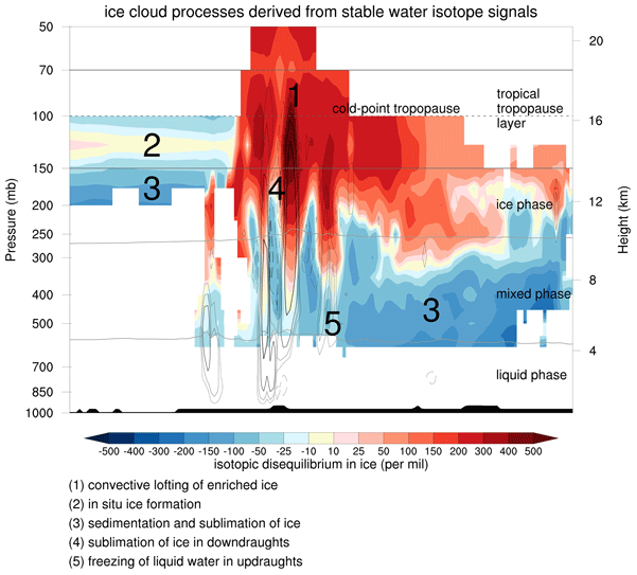
This study investigates the formation of ice clouds related to deep convection in the West African monsoon, using stable water isotopes as tracers of moist processes. In the convection-permitting simulations, performed with the COSMOiso model, the following five key processes related to tropical ice clouds can be distinguished based on isotope information (see figure): (1) convective lofting of enriched ice into the upper troposphere, (2) cirrus clouds that form in situ from ambient vapour under equilibrium fractionation, (3) sedimentation and sublimation of ice in the mixed-phase cloud layer, (4) sublimation of ice in convective downdraughts, and (5) the freezing of liquid water just above the 0◦C isotherm in convective updraughts. This study demonstrates that isotopes are useful to disentangle the role of different processes in the West African monsoon water cycle and their impact on the tropical tropopause layer. The study has been selected as a highlight paper in ACP.
De Vries, A. J., F. Aemisegger, S. Pfahl, and H. Wernli, (2022): Stable water isotope signals in tropical ice clouds in the West African monsoon simulated with a regional convection-permitting model. Atmos. Chem. Phys., 22, 8863–8895. external pagehttps://doi.org/10.5194/acp-22-8863-2022call_made
Lagrangian Particle Dispersion Models in the Grey Zone of Turbulence: Adaptations to FLEXPART-COSMO for Simulations at 1 km Grid Resolution
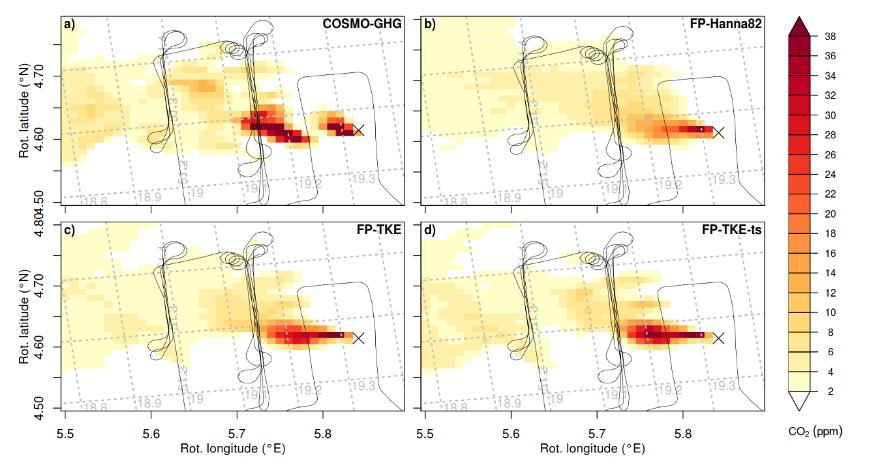
For the last decade, the atmospheric transport model FLEXPART-COSMO, run at 7 km horizontal resolution, formed the backbone of numerous studies on greenhouse gas emissions. However, when using higher resolution COSMO (1 km resolution) to drive FLEXPART, transport became too dispersive. This study demonstrates that a double representation of turbulent transport (partly resolved by COSMO grid-scale winds, and also parameterised as a stochastic process in FLEXPART) is responsible for additional dispersion. We suggest an alternative turbulence parameterisation for FLEXPART, which aligns the turbulent kinetic energy between COSMO and FLEXPART. The performance of FLEXPART using the new parameterisation is validated against observations of a power plant plume and long-term methane observations at a tall tower site. The new parameterisation clearly improves model performance in both cases. Future inverse modelling of Swiss greenhouse gas emissions is expected to largely benefit from these model developments.
Katharopoulos, I., Brunner, D., Emmenegger, L., Leuenberger, M., and Henne, S (2022): Lagrangian Particle Dispersion Models in the Grey Zone of Turbulence: Adaptations to FLEXPART-COSMO for Simulations at 1 km Grid Resolution, Bound. Lay. Met., doi: external page10.1007/s10546-022-00728-3call_made
An ensemble-based statistical methodology to detect differences in weather and climate model executables
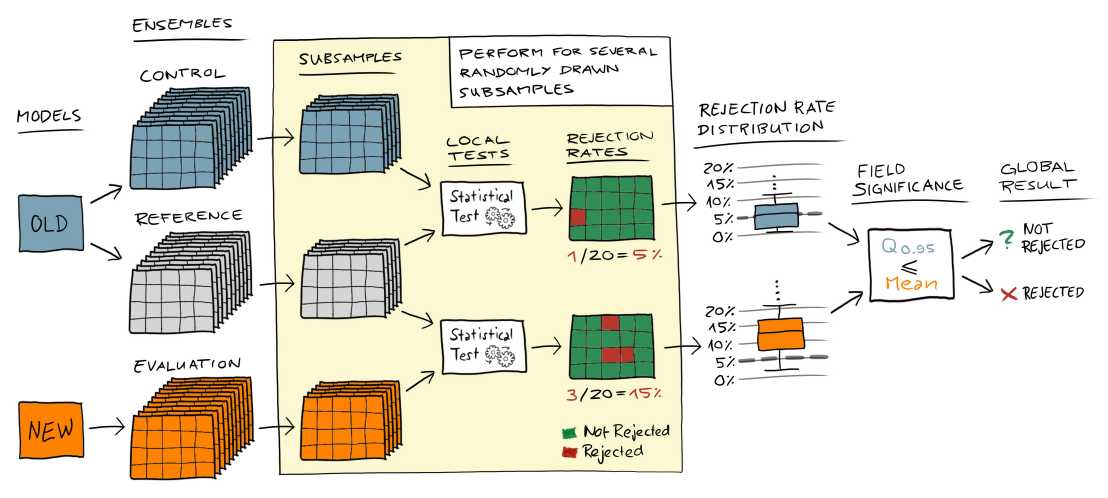
Many changes in weather and climate models are not meant to change the model behavior (i.e., code rearrangements or changes in hardware/software infrastructure). However, verifying such changes is challenged by the chaotic nature of our atmosphere, where even rounding errors can significantly impact individual simulations.
We propose a new methodology for quantifying and verifying the impacts of such changes by using ensemble simulations in combination with a statistical hypothesis test at the grid-cell level.
The methodology shows great sensitivity and can detect changes such as a tiny amount of added diffusion or the switch from double to single precision in the COSMO model. However, the test showed no differences after a major system update of Piz Daint or between the GPU and CPU versions of COSMO.
Our results suggest that short-term ensemble simulations are best suited for the methodology, making the test computationally inexpensive and thus ideal for automated testing.
Zeman, C. and Schär, C (2022).: An ensemble-based statistical methodology to detect differences in weather and climate model executables, Geosci. Model Dev., 15, 3183–3203, external pagehttps://doi.org/10.5194/gmd-15-3183-2022call_madeexternal pagecall_made
21st Century Alpine Climate Change
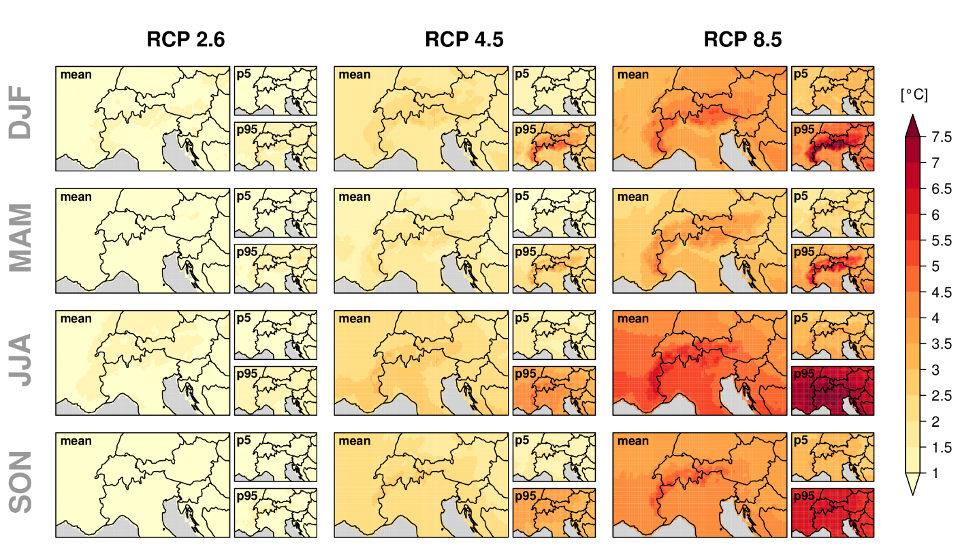
A new paper published in Climate Dynamics exploits the EURO-CORDEX RCM ensemble (the same ensemble as used for CH2018) to quantify projected future climate change on an Alpine scale. Results reveal that the entire Alpine region will face a warmer climate in the course of the twenty-first century for all emission scenarios considered. Strongest warming is projected for the summer season, for regions south of the main Alpine ridge and for the high-end RCP 8.5 scenario. Depending on the season, medium to high elevations might experience an amplified warming. Model uncertainty can be considerable, but the major warming patterns are consistent across the ensemble. Among other indicators, surface snow cover will be strongly affected by the projected climatic changes and will be subject to a widespread decrease except for very high elevation settings.
Kotlarski S, Gobiet A, Morin S, Olefs M, Rajczak J, Samacoits R (2022): 21st Century Alpine Climate Change. Climate Dynamics, external pagehttps://doi.org/10.1007/s00382-022-06303-3.call_madeexternal pagecall_madeexternal pagecall_made
Internal variability and decadal-scale trends of surface solar radiation
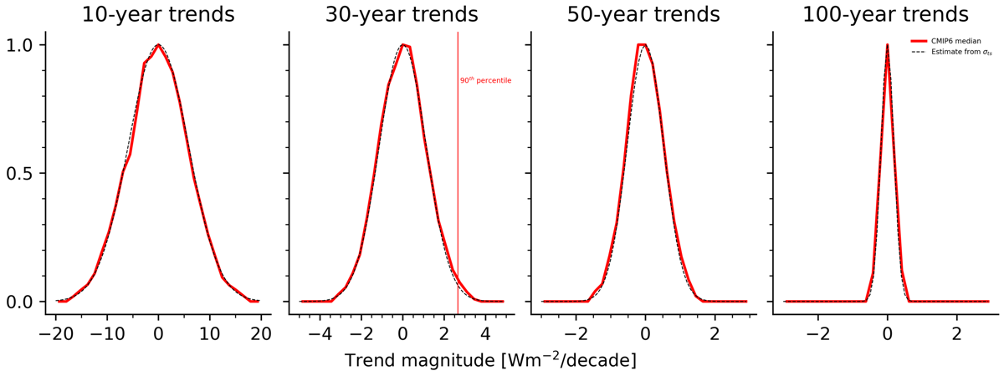
The climate science community has since long pinpointed the importance of understanding unforced climate variability for a better evaluation of climate projections. Internal variability (a.k.a. noise) arises solely from processes intrinsic to the climate system and is amplified by the non-linear interactions between them. One of the reasons for running forced simulations with many ensemble members is to test the models' response with different background states of the noise. This helps to better distinguish their response to external forcings from noise. Yet it still does not enable a direct one-to-one comparison with observations, because we cannot really simulate all components of the background state in their correct phases and amplitudes at the correct times. We take an alternative, statistical approach to gain a better understanding and quantitative estimate of the influence of internal variability on decadal-scale trends of surface solar radiation (SSR), a key energy budget variable. We performed a statistical analysis on unforced multi-century control simulations from the Coupled Models Intercomparison Project – Phase 6 (CMIP6), which do not include any natural (e.g., volcanoes) or anthropogenic (e.g., greenhouse gases and aerosols) forcings. We show that for annual mean SSR the distribution of all possible N-year trends can be analytically derived from the standard deviation of the underlying time series (σts). This results from two important properties of the annual mean SSR time series: that the distribution of all values is Gaussian and that there is no autocorrelation in time. Based on our analysis, we can estimate the probability of an unforced trend (or the unforced component contributing to a trend) for any location on the planet. The figure shows the simulated trend distribution over different N-year periods for Lindenberg, Germany. At this location, an unforced trend with a magnitude of 2.7 Wm-2/decade can be sustained over 30-years with a probability of 10% (90th percentile of the 30-year trends distribution). The magnitude of unforced trends decreases over longer time scales or when spatially averaged.
Chtirkova, B., Folini, D., Correa, L. F., & Wild, M. (2022). Internal variability of all-sky and clear-sky surface solar radiation on decadal timescales. Journal of Geophysical Research: Atmospheres, 127, e2021JD036332. external pagehttps://doi.org/10.1029/2021JD036332call_madeexternal pagecall_madeexternal pagecall_madeexternal pagecall_made
Aerosol’s fingerprint on clouds: Increases in cloud cover appear to dominate the cooling effect

Aerosol’s fingerprint on clouds remains the largest uncertainty for climate forcing since decades. The impacts derived from climate models are poorly constrained by observations because retrieving robust large-scale signals of aerosol–cloud interactions is frequently hampered by the considerable noise associated with meteorological co-variability.
To solve this, we pioneer a new novel approach to distinguish the aerosol’s fingerprint in clouds from natural variability using an unprecedented effusive volcanic eruption in Iceland in 2014 as a natural experiment. This approach combines modern machine-learning data-science technique and long-term satellite remote sensing records, to generate an emulator which tells us how clouds would look like in the absence of aerosol perturbation.
Our analysis shows that aerosols from the eruption increased cloud cover by approximately 10%, and this appears to be the leading cause of climate forcing, rather than cloud brightening as previously thought. We find that volcanic aerosols do brighten clouds by reducing droplet size, but this has a notably smaller radiative impact than changes in cloud fraction.
Chen, Y., Haywood, J., Wang, Y., Malavelle, F., Jordan, G., Partridge, D., Fieldsend, J., De Leeuw, J., Schmidt, A., Cho, N., Oreopoulos, L., Platnick, S., Grosvenor, D., Field, P., and Lohmann, U (2022): Machine learning reveals climate forcing from aerosols is dominated by increased cloud cover, Nature Geoscience, external pagehttps://doi.org/10.1038/s41561-022-00991-6call_madeexternal pagecall_madeexternal pagecall_madeexternal pagecall_madeexternal pagecall_made



